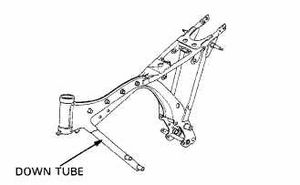Difference between revisions of "Diamond frame"
Jump to navigation
Jump to search
(Created page with "Tubular frame design common until World War II and derived from the bicycle layout. The engine cases often form part of the structure. In profile it resembles a diamond shape...") |
|||
| (2 intermediate revisions by the same user not shown) | |||
| Line 1: | Line 1: | ||
Tubular frame design common until World War II and derived from the bicycle layout. The [[engine]] cases often form part of the structure. In profile it resembles a diamond shape. | [[File:Diamond frame type.jpg|thumb|300px|right|Diamond frame type.jpg]] | ||
Tubular frame design common until World War II and derived from the bicycle layout. The [[engine]] cases often form part of the structure. In profile it resembles a diamond shape. With a diamond frame, lower section of down tube is not connected with other frame tubes. The engine forms the final portion of the frame structure and generates the frame strength. | |||
The diamond frame is used mainly on small and middlesize vehicles due to the simplicity of its structure and its light weight and excellent serviceability. | |||
[[Category:Definitions]] | [[Category:Definitions]] | ||
[[Category:Frames]] | [[Category:Frames]] | ||
Latest revision as of 21:18, 9 December 2010
Tubular frame design common until World War II and derived from the bicycle layout. The engine cases often form part of the structure. In profile it resembles a diamond shape. With a diamond frame, lower section of down tube is not connected with other frame tubes. The engine forms the final portion of the frame structure and generates the frame strength. The diamond frame is used mainly on small and middlesize vehicles due to the simplicity of its structure and its light weight and excellent serviceability.
